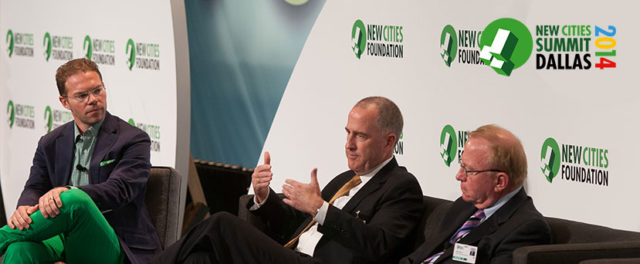Are you Connected to a Global Hub?
October 31, 2014 — Blog
This post is part of our Re-imagining Cities discussion series, following the third edition of the NewCities Summit in Dallas in June 2014.
Air hubs play a key role in the development of the cities that they are attached to. Using Dallas/Fort Worth International Airport as a springboard, this panel’s moderator Greg Lindsay asked the speakers to look more broadly at the future for air hubs in light of a rapidly shifting economic landscape.
The conversation began with an exploration of the correlation between the opening of Dallas/Fort Worth International Airport and the economic growth of its surrounding region. For the airport CEO, Sean Donohue, the economic windfall generated by large, globally oriented air hubs and their surrounding cities and communities is undisputable. DFW International airport alone, according to Donohue, generates around $31 billion to the annual local economy. Last year, DFW was the fastest growing US gateway in the past year. Overseas routes to Shanghai and Hong Kong alone are set to bring in $200 million in business. In tandem, Mike Boyd pointed out that as air patterns change and the global economy shifts, the main issue is not whether you live near to an airport, but “Are you connected to a global hub?”
As air patterns change and the global economy shifts, the main issue is not whether you live near to an airport, but “Are you connected to a global hub?” – Mike Boyd
The panelists agreed that cities must ensure that air hubs are well integrated into the urban area. This requires excellent public transport links to the town center, and the Dallas Area Rapid Transit (DART) line was cited as a useful example.
Greg Lindsay challenged the panelists to consider potential competition between DFW and other air hubs in the Middle East, China and elsewhere. How can an air hub continue to attract more international carriers and remain competitive?
For Donohue, it is the airport’s responsibility to attract business through incentives, but it is up to the wider network of partners and the community to ensure that the services are a sustainable success. Looking to the future, Boyd asserted his confidence that airports such as DFW and Detroit would remain major hubs, because they are well connected to local traffic – unlike airports in the Middle East, for example.
Throughout the conversation, the panelists agreed upon the need to be as technologically modern as possible. For Donohue, it was the twin areas of customs and immigration that could best benefit from the latest in technological innovation. With better technology, passenger transit could be sped up to such an extent that an airport could increase its overall traffic capacity while adding new routes.
In addition, newer technologies could also have a desirable green effect on the enormous carbon footprint made by almost any airport. The “smarter” technologies could work to diminish the carbon emissions from an airport’s huge central utilities and power grid.

Speakers
- Mike Boyd, President, Boyd Group International – @BoydGroup
- Sean Donohue, Chief Executive Officer, Dallas/Fort Worth International Airport – @dfwairport
Moderated by: Greg Lindsay, Contributing Writer, Fast Company and Senior Fellow, World Policy Institute – @Greg_Lindsay
